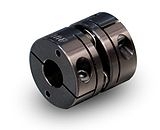
Disc coupling
Encyclopedia
Disc coupling: by definition, transmits torque from a driving to a driven bolt tangentially on a common bolt circle. Torque is transmitted between the bolts through a series of thin, stainless steel discs assembled in a pack. Misalignment is accomplished by deforming of the material between the bolts.
A disc coupling is a high performance motion control (Servo) coupling
designed to be the torque
transmitting element (by connecting two shafts
together) while accommodating for shaft misalignment
. It is designed to be flexible, while remaining torsionally
strong under high torque loads. Typically, disc couplings can handle speeds up to 10,000 RPM
.
There are two different styles of disc coupling:
The difference between the two styles is that single disc couplings cannot accommodate parallel misalignment due to the complex bending that would be required of the lone disc. Double disc styles allow the two discs to bend in opposite directions to better manage parallel offset. The discs are fastened to the hubs (and center spacer on double disc styles) with tight fitting pins that do not allow any play or backlash between the disc and the hubs. The discs can be bent easily and as a result, disc couplings have some of the lowest bearing loads available in a motion control coupling.
Torsionally stiff and still flexible, disc couplings are a great solution for high speed applications. The downside is that they are more delicate than the average coupling and can be damaged if misused. Special care should be taken to ensure that misalignment is within the ratings of the coupling.
A disc coupling is a high performance motion control (Servo) coupling
Coupling
A coupling is a device used to connect two shafts together at their ends for the purpose of transmitting power. Couplings do not normally allow disconnection of shafts during operation, however there are torque limiting couplings which can slip or disconnect when some torque limit is exceeded.The...
designed to be the torque
Torque
Torque, moment or moment of force , is the tendency of a force to rotate an object about an axis, fulcrum, or pivot. Just as a force is a push or a pull, a torque can be thought of as a twist....
transmitting element (by connecting two shafts
Driveshaft
A drive shaft, driveshaft, driving shaft, propeller shaft, or Cardan shaft is a mechanical component for transmitting torque and rotation, usually used to connect other components of a drive train that cannot be connected directly because of distance or the need to allow for relative movement...
together) while accommodating for shaft misalignment
Shaft alignment
Shaft alignment is the process to align two or more shafts with each other to within a tolerated margin. It is an absolute requirement for machinery before the machinery is put in service....
. It is designed to be flexible, while remaining torsionally
Torsion (mechanics)
In solid mechanics, torsion is the twisting of an object due to an applied torque. In sections perpendicular to the torque axis, the resultant shear stress in this section is perpendicular to the radius....
strong under high torque loads. Typically, disc couplings can handle speeds up to 10,000 RPM
Revolutions per minute
Revolutions per minute is a measure of the frequency of a rotation. It annotates the number of full rotations completed in one minute around a fixed axis...
.
There are two different styles of disc coupling:
| Single Disc Style couplings are composed of two hubs (the ends of the coupling, which are typically made from aluminum, but stainless steel is used as well) and a single, flat, stainless steel disc spring. | |
| Double Disc Style coupling is also composed of two hubs, but has an additional center spacer sandwiching two disc springs. The center spacer can be made out of the same material as the hubs, but is sometimes available in insulating acetal, which makes the coupling electrically isolating. |
The difference between the two styles is that single disc couplings cannot accommodate parallel misalignment due to the complex bending that would be required of the lone disc. Double disc styles allow the two discs to bend in opposite directions to better manage parallel offset. The discs are fastened to the hubs (and center spacer on double disc styles) with tight fitting pins that do not allow any play or backlash between the disc and the hubs. The discs can be bent easily and as a result, disc couplings have some of the lowest bearing loads available in a motion control coupling.
Torsionally stiff and still flexible, disc couplings are a great solution for high speed applications. The downside is that they are more delicate than the average coupling and can be damaged if misused. Special care should be taken to ensure that misalignment is within the ratings of the coupling.
See also
- Oldham coupling
- Resilient couplingCompliant mechanismIn mechanical engineering, compliant mechanisms are flexible mechanisms that transfer an input force or displacement to another point through elastic body deformation...
- Thompson coupling
- Universal couplingUniversal jointA universal joint, universal coupling, U joint, Cardan joint, Hardy-Spicer joint, or Hooke's joint is a joint or coupling in a rigid rod that allows the rod to 'bend' in any direction, and is commonly used in shafts that transmit rotary motion...

